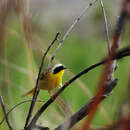en
names in breadcrumbs


Both the appearance (especially of the males) and the vocalizations of the Common Yellowthroat are very striking. They are so characteristic of wetland habitats that they provide a distinguished presence to these areas (Fisher and Acorn 1998).
Perception Channels: visual ; tactile ; acoustic ; chemical
There has been a general decline in neotropical migrants. However, the yellowthroat is a very common species of wood warbler and the only threats to its status may be the parasitism of cowbirds and the possibility of habitat loss from development of open areas or wetlands.
US Migratory Bird Act: protected
US Federal List: no special status
CITES: no special status
State of Michigan List: no special status
IUCN Red List of Threatened Species: least concern
The Common Yellowthroat has no known negative impact on humans.
Yellowthroats are a pleasant addition to the variety of sights and sounds of wetlands.
They eat many different species of insects, some of which may pose as pests to humans.
The yellowthroat is generally an insectivore. It gleans leaves of shrubbery, grasses or weeds for adult and larval insects such as grasshoppers, dragonflies, beetles, butterflies, and spiders. Seeds are sometimes eaten as well (Fisher and Acorn 1998; Terres 1980).
Geothlypis trichas nest in Alaska and from the Atlantic Ocean to the Pacific Ocean across Canada and the United States. They also nest further south into Mexico. Their wintering range is from southern United States to northern South America and into the West Indies (Terres 1980; Versaware 2000).
Biogeographic Regions: nearctic (Native ); neotropical (Native )
Common Yellowthroats occupy non-forested areas low to the ground in briers, damp brushy places, weeds or grasses along country roads or agricultural environments. They are also found in cattails, bulrushes, sedges, and willows by streamsides, swamps, freshwater, and salt-water marshes. They occupy similar types of habitats for both their breeding and wintering locations (Fisher and Acorn 1998; Rogers 2000; Terres 1980).
Terrestrial Biomes: savanna or grassland
Average lifespan
Status: wild: 138 months.
Common Yellowthroats are wren-like wood warblers with upturned tails. They are 11 to 14 cm in length. The males are olive green above and have a year round black facial mask, bordered above by a blue-white band. They have a white belly with pale yellow chin, throat, breast, and undertail coverts. The beak is black and the legs are a pinkish color. The females look similar to the males but lack the black facial mask. Immature yellowthroats are dull brown with the males' face showing a drab facial mask (Rogers 2000; Terres 1980; Tufts 1986).
Range mass: 7.3 to 13.6 g.
Other Physical Features: endothermic ; bilateral symmetry
Average basal metabolic rate: 0.17622 W.
The female yellowthroat lays her eggs between April and July, and incubates 3-5 eggs for 12 days. The eggs are white or cream-white and are speckled brown, black, or grey at the large end. The cup-shaped, bulky nest made from dead leaves, coarse grass and weed stems, with a lining of fine black rootlets, is located low to the ground, in shrubbery. While only the female incubates the eggs, both the male and female tend the young. The young are altricial and leave the nest 8 days after hatching (Ehrlich et al. 1988; Fisher and Acorn 1998; Terres 1980; Tufts 1986).
Key Reproductive Features: iteroparous ; gonochoric/gonochoristic/dioecious (sexes separate); sexual ; oviparous
Average time to hatching: 12 days.